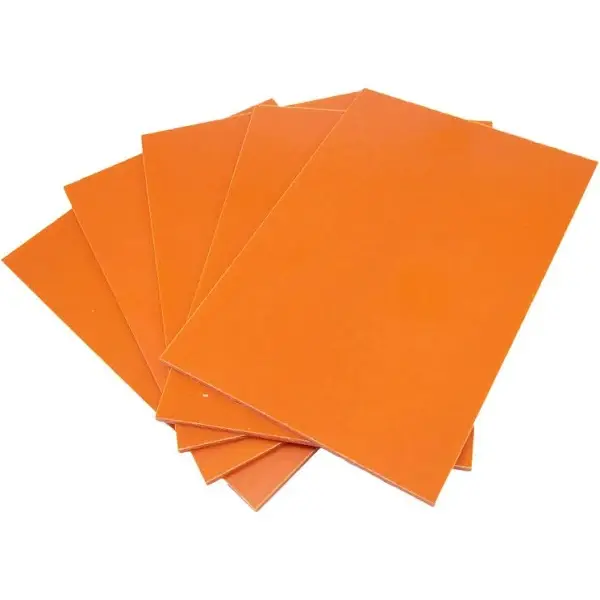Key Characteristics Indicating Premium Phenolic Paper
Structural Integrity and Uniformity
Premium phenolic paper sheets boast exceptional structural integrity. This manifests in their ability to maintain shape and form under various stresses. High-quality sheets exhibit minimal warping or deformation, even when subjected to significant loads or environmental changes. Uniformity is another hallmark of superior phenolic paper. This encompasses consistency in thickness across the entire sheet, as well as a homogeneous distribution of the phenolic resin throughout the paper layers. Such uniformity ensures reliable performance across the entire surface area of the sheet, critical for applications requiring precision and consistency.
Chemical and Thermal Resistance
Top-tier phenolic paper sheets showcase remarkable resistance to a wide array of chemicals. This resistance extends to acids, alkalis, and various solvents, making these sheets suitable for use in harsh industrial environments. The chemical stability of high-quality phenolic paper prevents degradation, ensuring longevity and reliability in demanding applications. Thermal resistance is another crucial indicator of quality. Premium sheets can withstand elevated temperatures without compromising their structural or electrical properties. This thermal stability allows for their use in high-temperature environments, expanding their applicability across various industries.
Electrical Insulation Properties
Exceptional electrical insulation is a defining characteristic of high-quality phenolic paper sheets. These sheets exhibit high dielectric strength, effectively preventing the passage of electrical current through the material. This property is vital in applications where electrical safety and performance are paramount. Superior phenolic paper sheets also maintain their insulating properties over time and under varying environmental conditions. Low moisture absorption further enhances their electrical insulation capabilities, as water uptake can compromise insulating properties. The combination of these factors makes premium phenolic paper sheets invaluable in electrical and electronic applications.
Appearance and Moisture-Resistance Inspection Checklist
Visual Examination Techniques
A thorough visual examination forms the first step in identifying high-quality phenolic paper sheets. Start by inspecting the sheet under good lighting conditions. Look for a uniform color distribution across the entire surface. Premium sheets typically showcase a consistent hue without noticeable variations or discolored patches. Run your hand over the surface to detect any irregularities. High-quality sheets should feel smooth and even, free from bumps, indentations, or rough spots. Examine the edges of the sheet for signs of delamination or separation between layers. Quality phenolic paper sheets should have tightly bonded layers with no visible separation. Lastly, hold the sheet up to a light source to check for any inconsistencies in thickness or density that might appear as lighter or darker areas.
Moisture Absorption Test Methods
Assessing moisture resistance is crucial in determining the quality of phenolic paper sheets. One simple test involves placing a small water droplet on the sheet's surface and observing its behavior. On high-quality sheets, the droplet should bead up and remain on the surface without being absorbed quickly. For a more quantitative approach, you can conduct a water absorption test. Cut a small sample of the sheet, weigh it, then immerse it in water for a specified period (e.g., 24 hours). After drying the surface, weigh the sample again. The difference in weight indicates the amount of water absorbed. Premium phenolic paper sheets should show minimal weight gain, typically less than 1% of their original weight. Another method involves measuring the dimensional changes of a sample before and after exposure to high humidity. Quality sheets should exhibit minimal swelling or warping.
Surface Finish Evaluation
The surface finish of phenolic paper sheets provides valuable insights into their quality. Begin by examining the sheet under different lighting angles to detect any surface imperfections. High-quality sheets should have a consistent sheen across their surface without dull spots or irregularities. Use a magnifying glass to inspect the surface closely for any pinholes, scratches, or other minor defects. Premium sheets should be virtually free from such imperfections. To evaluate smoothness, you can employ a profilometer if available. This instrument measures surface roughness with high precision. Alternatively, a simple comparison test using sheets of known quality can help assess relative smoothness. Lastly, check for any signs of surface contamination or residues, which could indicate poor manufacturing processes or improper handling. Clean, pristine surfaces are characteristic of high-quality phenolic paper sheets.
Laboratory Tests for Mechanical and Electrical Performance
Flexural Strength Assessment
Flexural strength testing provides crucial insights into the mechanical performance of phenolic paper sheets. This test measures the sheet's ability to resist deformation under load. The three-point bending test is commonly employed for this purpose. In this procedure, a sample of the phenolic paper sheet is supported at two points and a force is applied at the midpoint until the sample fails. The maximum stress the material can withstand before failure is recorded as its flexural strength. High-quality phenolic paper sheets typically exhibit flexural strengths ranging from 100 to 170 MPa, depending on the specific grade and composition. During the test, observe the behavior of the sample. Premium sheets should show some degree of elastic deformation before failure, rather than sudden, brittle fracture. The flexural modulus, which indicates the sheet's stiffness, can also be calculated from this test. Superior phenolic paper sheets often have flexural moduli between 7 and 14 GPa.
Dielectric Strength Measurement
Dielectric strength is a critical parameter for evaluating the electrical insulation properties of phenolic paper sheets. This test determines the maximum electric field the material can withstand without breaking down. The procedure involves placing a sample of the sheet between two electrodes and gradually increasing the voltage until electrical breakdown occurs. The voltage at which this happens, divided by the thickness of the sample, gives the dielectric strength. High-quality phenolic paper sheets typically demonstrate dielectric strengths in the range of 15 to 20 kV/mm. During testing, pay attention to the consistency of results across multiple samples. Premium sheets should show minimal variation in dielectric strength, indicating uniform composition and manufacturing quality. Additionally, consider performing this test under different environmental conditions, such as elevated temperatures or high humidity, to assess the material's performance in challenging environments.
Impact Resistance Evaluation
Impact resistance testing assesses the ability of phenolic paper sheets to absorb energy during sudden, high-force impacts without fracturing. The Izod impact test is commonly used for this evaluation. In this test, a notched sample of the sheet is struck by a pendulum, and the energy absorbed during the impact is measured. High-quality phenolic paper sheets typically exhibit impact strengths ranging from 5 to 15 kJ/m², depending on the specific formulation. Observe the nature of the failure during the test. Premium sheets often show a combination of ductile and brittle behavior, rather than purely brittle fracture. This indicates a balance between strength and toughness. Consider performing impact tests at different temperatures to evaluate the material's performance across a range of operating conditions. Superior phenolic paper sheets maintain good impact resistance even at low temperatures, where many materials become more brittle.
Conclusion
Identifying high-quality phenolic paper sheets requires a comprehensive approach combining visual inspection, physical testing, and laboratory analysis. By evaluating characteristics such as structural integrity, chemical resistance, electrical insulation properties, and mechanical performance, you can ensure the selection of premium materials suitable for demanding applications. Remember that while visual and simple physical tests provide valuable initial insights, professional laboratory testing offers the most definitive assessment of a sheet's quality and performance capabilities. Investing time in thorough evaluation pays dividends in the long-term reliability and effectiveness of your engineering projects.
Contact Us
For more information about our high-quality phenolic paper sheets or to discuss your specific requirements, please contact us at info@jhd-material.com. Our team of experts is ready to assist you in finding the perfect solution for your needs.






